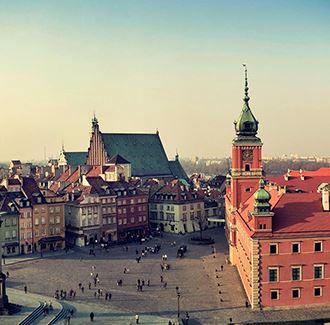Warsaw: History Divided By a River
Identity
Warsaw was founded around 1300, and early on it became a major trade centre and meeting point for the many peoples of Central Europe. The variety found in streets' architecture and design, where stark differences can be found between different neighbourhoods, is a clear sign of a multicultural past: a population of Poles, Germans and Russians, with the Catholic, Protestant and Jewish religions crossing paths. This is also a troubled past, with periods of prosperity interrupted by crises and wars: between the 17th and 19th Centuries, the city was invaded by the Germans, the Swedish and the French (led by Napoleon Bonaparte), ending with a period of Russian domination.
The latest of these great conflicts — Second World War — almost completely devastated the city. During the Communist regime, several historical landmarks were rebuilt, which helped to recover some of the lost heritage but also led to the creation of new areas with the typical Soviet architecture. When Poland joined the European Union, more colours were added to the "painting". As a result, to this day the different areas of the city have distinct identities, with one particularly visible division: on the left bank of the Vistula river that cuts through the city we find old, classical Warsaw. On the right bank of the river, we can witness the birth of a new city.
Left Bank and Historic Centre
To learn about Warsaw's distant past, we must begin our visit at the Śródmieście city district, where we find the historic centre — the Old City (Stare Miasto), which was granted UNESCO World Heritage Status in 1980.

The Poles' highly religious nature is evident in religious buildings from several historical periods, such as the Gothic-style Saint John's Cathedral, the neighbouring Baroque Jesuite Church, or the Church of Saint Alexander, built during the Russian rule. The 18th century Church of the Holy Cross is also of great interest, being the resting place for the heart of Frédéric Chopin, the mythical Franco-Polish pianist and composer that left a mark in 19th Century Romantic music. After visiting, you might as well head for the Ostrogski Palace, where the Fryderyk Chopin Museum is housed.
At the Old Town Square, where the old buildings were rebuilt according to their original 15th and 16th Century designs, we can find a bit of Gothic and medieval Warsaw as well as the Royal Castle, bearing 18th Century décor, a landmark that was also completely rebuilt after the war. At Łazienki Park, one of the city's main attractions, you can enjoy over 80 hectares of pure green as well as a visit to the palace housing the Royal Lazienki Museum. Nearby, it is also possible to visit the Wilanów Palace, surrounded by Italian gardens, and the Belweder Palace.

Close to Piłsudski Square is one of many local green areas: the 17th century Saxon Garden, known for being one of the world's oldest public gardens. Through here we can get to the nearest neighbourhood, known as the “New Town” (Nowe Miasto). Here we find the New Town Market Square — after its complete destruction during the Second World War it was rebuilt according to its characteristic 18th Century design.
Several monuments in Warsaw's city centre help us to get acquainted with Polish History and its main characters: the Tomb of the Unknown Soldier, on Piłsudski Square; a monument celebrating the Warsaw Ghetto Uprising; a statue of Chopin at Łazienki Park; a monument dedicated to scientist Nicolaus Copernicus on the Krakowskie Przedmieṡcie area; or the Jewish Cemetery, one of Europe's largest.
Towards the Right Bank, the 20th Century and Beyond
Close by, to the South, we can find signs of modern times such as the Palace of Culture and Science, a 1950's Soviet skyscraper that is currently home to shops, galleries, movie theatres and performance venues. The “Palace” is a symbol of the rebuilt, post-war Warsaw. Today, after the country's admission to the European Union, the city is still growing and changing.



Once in Praga-Południe, we can breathe fresh air at the Skaryszewski Park, known for its great size and monuments honouring Polish composer Jan Paderewski and the Allied soldiers that fought during the Second World War. To the North, we are surprised by the Soho Factory, a former industrial area that has been brought back to life by Warsaw's new generations — currently it is a centre for art galleries, designer shops, restaurants and markets, and is a meeting point for the city's youth and its creative class.
There are other peculiar things to be found in this area, such as tourism companies that organise tours through Warsaw's Cold War period landmarks. On a similar note, you can visit the Neon Museum: an institution dedicated to the preservation of Poland's Communist era neon signs! Finally, if you want to dive deep into the night or go clubbing, it is time to head North towards Praga-Północ, a great place to discover clubs, bars and music venues and get to know Warsaw's bohemian side!

